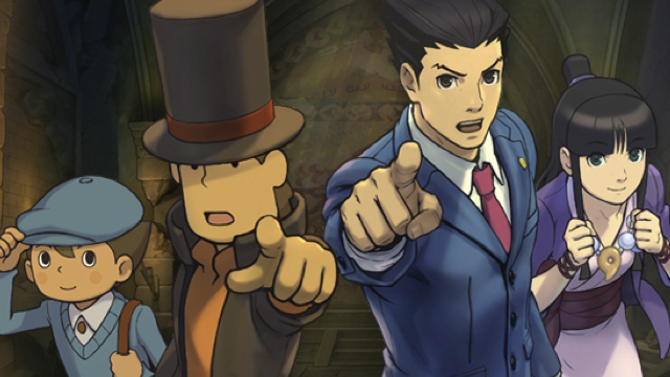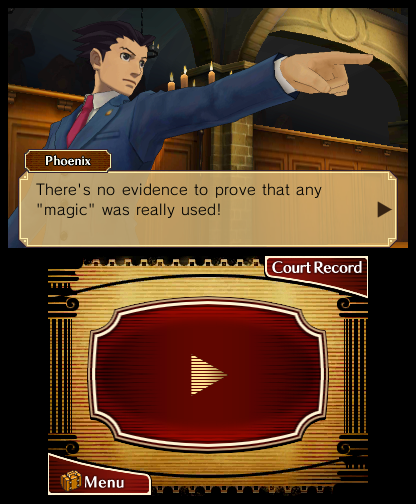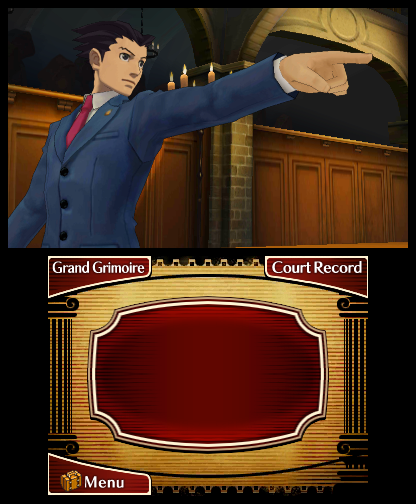For years I've been pining for the North American release of Professor Layton vs. Phoenix Wright: Ace Attorney and was overjoyed when both the localization and release date was officially announced. Naturally, the crossover title was my number one pick for the preview event and I was all too eager to get my hands on it.
Professor Layton vs. Phoenix Wright has the two titular protagonists, alongside their trusty partners Luke and Maya, solving an unfolding mystery in a medieval-style world. Players must take control of Phoenix Wright during Witch Trial segments, which has him cross-examine one or more witness(es) in order to defend his client Espella Cantabella.
In the demo I played, I had to cross-examine Freighter security guard named Johnny Smiles who insisted he saw Espella committing the act of murder. This process retained the familiar format of previous Ace Attorney titles -- you look through testimony and either press for more information or present evidence (stored in the Court Records) to expose a contradiction. Later, through required cross-examinations, players get to sort through multiple testimonies at once.
The beginning of each trial is fully voiced, including the judge, prosecutor, Maya and Phoenix himself. Interestingly enough, Phoenix is not voice by Sam Riegel here (who played him in Ultimate Marvel vs. Capcom 3 and Ace Attorney - Dual Destinies) but by Trevor White. White does a great job voicing Phoenix, so the change is odd but not problematic.
Another difference I noticed involves the penalty system. In the first Ace Attorney title, there was a five strike ("!") system that has since been replaced by the penalty bar. Professor Layton vs. Phoenix Wright: Ace Attorney curiously returns to the original five strikes mechanic, which is a very strange change to make.
After trying out cross examination segment, Staff Writer Ryan Meitzler jumped in and handled the Investigation section while I watched on. Here, Professor Layton is in charge of investigating the mysterious city of Labyrinthia in order to uncover more information. These parts play like a classic Professor Layton title, with the player using the stylus to investigate various points of interest and sometimes discover puzzles needing to be solved. Hint Coins, which are used to "purchase" hints for said puzzles, are also scattered around as previous Professor Layton games.
Scattered around the game are beautifully animated and voiced cut-scenes. I had a chance to see a few of these beautiful cut-scenes and was happy to see that they retained the French animation charm that we've come to love of Professor Layton titles. Like in the case of Phoenix however, I did noticed that Luke's voice actress was different. As it turns out, I was hearing the UK actress Maria Darling instead of the North American Lani Minella. At this point, though, it's unclear whether Darling will replace Minella for this game.
In-game graphics use 3D models instead of 2D sprite art and, for the most part, it looks great. The style of 3D is different though; unlike Dual Destinies, which used cell shading to mimic 2D, this title features more conventional 3D with some heavier shading thrown in. The character models are rendered well here (Layton characters translate surprisingly well to the style); except for Phoenix's face which looks weird and flat.
Professor Layton vs. Phoenix Wright: Ace Attorney plays well and manages to bridge two very different visual and gameplay styles into a cohesive and unique blend of a title. I'll be eagerly awaiting the North American release date of August 29th with bated breathe and even more anticipation in my heart.



